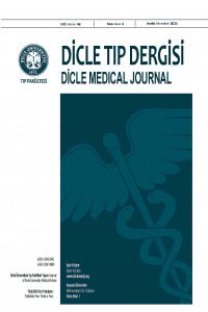The reasons for conversion from laparoscopic appendectomy to open surgery in children: the first experience on 100 cases in a single
Çocuklarda Laparoskopik Apendektomiden Açık Cerrahiye Geçiş Nedenleri: İlk 100 Vaka Deneyimİ
___
1. Masurkar AA. Laparoscopic Trans-Abdominal Retromuscular (TARM) Repair for Ventral Hernia: A Novel, Low-Cost Technique for Sublay and Posterior Component Separation. World J Surg. 2020; 44: 1081-5.2. Semm K. Endoscopic appendectomy. Endoscopy.1983; 15: 59–64.
3. Dumas RP, Subramanian M, Hodgman E, et al. Laparoscopic Appendectomy: A Report on 1164 Operations at a Single-Institution, Safety-Net Hospital. Am Surg. 2018; 84: 1110-6.
4. Ruiz-Patiño A, Rey S, Molina G, et al. Cost effectiveness of laparoscopic versus open appendectomy in developing nations: a Colombian analysis. J Surg Res. 2018; 224: 33-7.
5. Andert A, Alizai HP, Klink CD, et al. Risk factors for morbidity after appendectomy. Langenbecks Arch Surg. 2017; 402: 987-93.
6. Gupta N, Machado-Aranda D, Bennett K, et al. Identification of preoperative risk factors associated with the conversion of laparoscopic to open appendectomies. Int Surg. 2013; 98: 334-9.
7. Abe T, Nagaie T, Miyazaki M, et al. Risk factors of converting to laparotomy in laparoscopic appendectomy for acute appendicitis. Clin Exp Gastroenterol. 2013; 6: 109-14.
8. Finnerty BM, Wu X, Giambrone GP, et al. Conversion to open in laparoscopic appendectomy: A cohort analysis of risk factors and outcomes. Int J Surg. 2017; 40: 169-75.
9. Johnson KN, Linnaus M, Notrica DM. Conversion from laparoscopic to open appendectomy: decreased risk at dedicated children's hospitals. Pediatr Surg Int. 2018; 34: 873-7.
10. Gulpinar K, Ozdemir S, Ozis SE, et al. Single incision laparoscopic cholecystectomy by using a 2 mm a traumatic grasper without trocar. HPB Surg. 2011; 2011: 7613-15.
11. Donmez T, Sunamak O, Ferahman S, et al. Two port laparoscopic appendectomy with the help of a needle grasper: better cosmetic results and fewer trocars than conventional laparoscopic appendectomy. Videosurgery Miniinv. 2016; 11: 105–10 .
12. Michailidou M, Goldstein SD, Sacco Casamassima MG, et al. Laparoscopic versus open appendectomy in children: the effect of surgical technique on healthcare costs. Am J Surg. 2015; 210: 270-5.
13. Elikashvili I, Tay ET, Tsung JW. The effect of point of care ultrasonography on emergency department length of stay and computed tomography utilization in children with suspected appendicitis. Acad Emerg Med. 2014; 21: 163-70.
14. Arslan S, Aydogdu B, Arslan MS, et al. Analysis of Risk Factors for Appendicitis in Children: A Multicenter Epidemiological Study. Dicle Med J. 2016; 43: 556-60
- ISSN: 1300-2945
- Yayın Aralığı: 4
- Başlangıç: 1963
- Yayıncı: Cahfer GÜLOĞLU
Fikret SALIK, Mustafa BIÇAK, Hakan AKELMA, Sedat KAYA
Evaluation of Corneal Optic Quality in Amblyopia
Hasan ÖNCÜL, Mehmet Fuat ALAKUŞ
Ali Erdal KARAKAYA, AHMET GÖKHAN GÜLER, Ahmet Burak DOĞAN, Fatih YAZAR
Geriatrik Populasyonda Baş Boyun Cilt, Ciltaltı Tümöral Lezyonlarının İncelenmesi
Ragıp Onur ÖZTORNACI, Talih ÖZDAŞ, Emin KAPI, Kemal Koray BAL, Sedat ALAGÖZ, Elif Burcu ŞENYURT, Asiye Merve ERDOĞAN
COVİD-19 Geçiren Hastalarda Antikor Düzeylerinin Değerlendirilmesi
Özgür ASLAN, Ayser MIZRAKLI, Gülseren SAMANCI AKTAR, Arzu RAHMANALI ONUR
Atılım Armağan DEMİRTAŞ, Mine KARAHAN
Pediatrik Pyoderma Gangrenozum
Rana KAPUKAYA, Ahmet KAPUKAYA, İsmail AKÇAY
Cemal POLAT, Nuriye METE, Murat SÖKER
Fatih ÖZTÜRK, Adem ATICI, Yunus Emre OKUDAN, Ali Yaşar KILINÇ, Mehmet YAMAN, Hakkı ŞİMŞEK, Koray DEMİR, Serkan AKDAĞ
